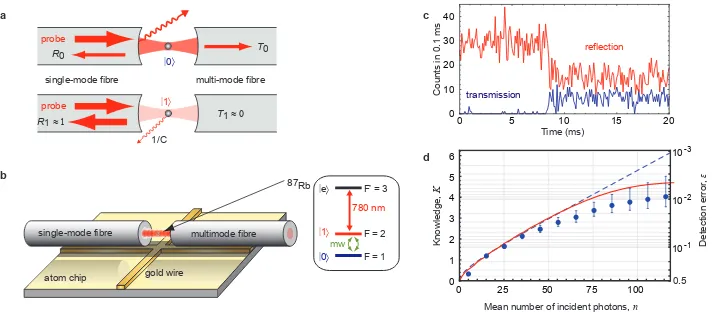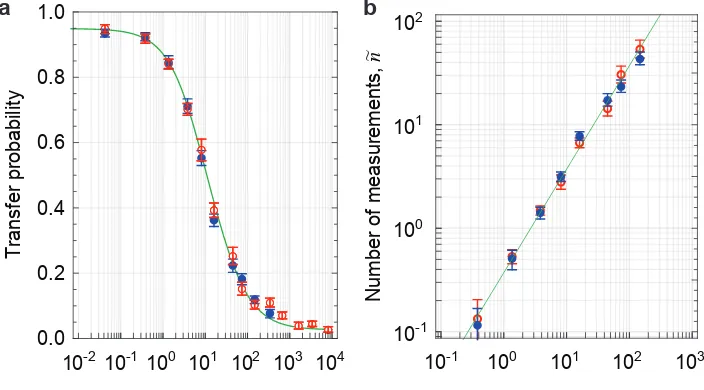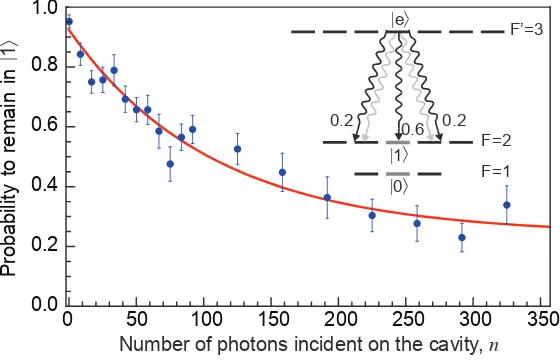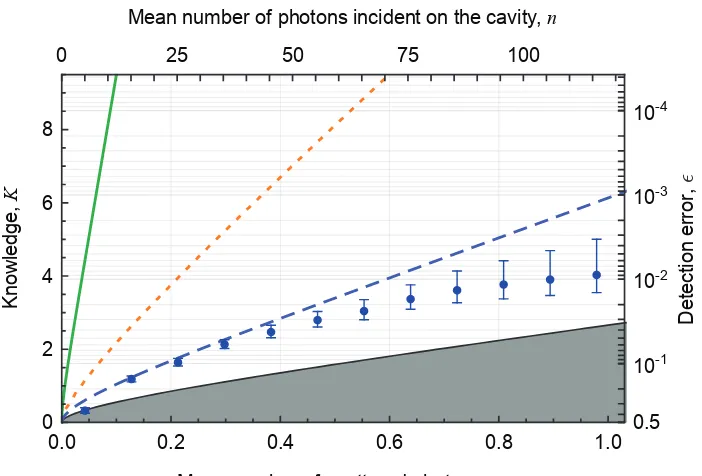Measuring the internal state of a single atom
without energy exchange
J¨urgen Volz1, Roger Gehr1, Guilhem Dubois1,2, J´erˆome Est`eve1 & Jakob Reichel1
1Laboratoire Kastler-Brossel, ENS, CNRS, UPMC,
24 rue Lhomond, 75005 Paris, France. 2Present address: Astron FIAMM, 83210 La Farl`ede, France
May 17, 2011
Real quantum measurements almost always cause a much stron-ger back action than required by the laws of quantum mechanics. Quantum non-demolition (QND) measurements have been devised [1–6] such that the additional back action is kept entirely within observables other than the one being measured. However, this back action to other observables often also imposes constraints. In particular, free-space optical detection methods for single atoms and ions such as the shelving technique [7], though being among the most sensitive and well-developed detection methods in quan-tum physics, inevitably require spontaneous scattering, even in the dispersive regime [8]. This causes irreversible energy exchange and heating, a limitation for atom-based quantum information process-ing where it obviates straightforward reuse of the qubit. No such energy exchange is required by quantum mechanics [9]. Here we experimentally demonstrate optical detection of an atomic qubit with significantly less than one spontaneous scattering event. We measure transmission and reflection of an optical cavity [10–13] containing the atom. In addition to the qubit detection itself, we quantitatively measure how much spontaneous scattering has occurred. This allows us to relate the information gained to the amount of spontaneous emission, and we obtain a detection er-ror below 10% while scattering less than 0.2 photons on average. Furthermore, we perform a quantum Zeno type experiment to quantify the measurement back action and find that every inci-dent photon leads to an almost complete state collapse. Together, these results constitute a full experimental characterisation of a quantum measurement in the “energy exchange-free” regime be-low a single spontaneous emission event. Besides its fundamental
interest, this means significant simplification for proposed neutral-atom quantum computation schemes [14] and may enable sensitive detection of molecules and atoms lacking closed transitions.
In the first step of a measurement, the system to be measured becomes entangled with another quantum object (“meter”), such as a photon field. For the case of a two-level system (qubit), (α|0i +β|1i) ⊗ |Ψini evolves intoα|0i ⊗ |Ψ0i+β|1i ⊗ |Ψ1i. The readout of the qubit then amounts to distinguishing the meter states|Ψ0i and |Ψ1i, which can only be achieved up to some error because they are generally nonorthogonal. The minimum possible detection errorǫ= (ǫ0+ǫ1)/2 is given by the Helstrom bound [15]
where ǫ0 and ǫ1 are the probabilities to measure the qubit in |1i although it was in|0iand vice versa and we assume no prior knowledge on the qubit state. In the following, we consider the generic case where a qubit is probed by an incident coherent light pulse containing n photons on average. To good approximation, the two final states |Ψ0i and |Ψ1i then also consist of coherent states. As an example, consider an ideal fluorescence measure-ment in which the dark state |0i does not interact with the light, while the bright state |1i scatters all photons. In this case, |Ψ0i =|0iS|niT and |Ψ1i=|niS|0iT, where |ni is a coherent pulse containing nphotons on av-erage, and S and T refer to the scattered and transmitted light modes. Then, |hΨ0|Ψ1i|2 = exp(−2n), and in the limit of large n one obtains
ǫH ≈ exp(−2n)/4. More generally, in all schemes using coherent pulses (so that |Ψ0i and |Ψ1i are tensor products of coherent states each con-taining a photon number proportional to n), |hΨ0|Ψ1i|2 = exp(−ζn) with some real ζ. This exponential decrease of the minimum detection error with n naturally leads to a heuristic definition of the “knowledge” on the atomic state as K ≡ −ln 2ǫ. The maximum knowledge KH one can ob-tain from a measurement is then KH = −ln 2ǫH. We use the notation
f(x) = −ln1−p
1−exp(−x), which for largex simplifies to f(x) ≈x. Thus, for coherent pulse schemes,KH=f(ζn) is the knowledge that the en-vironment has obtained during the measurement, and constitutes an upper bound to the knowledgeKaccthat the experimenter can actually access. In the case of the ideal fluorescence measurement, the maximum knowledge is
f(2n)≈2n.
real measurements, however, cause a much larger back action. In particu-lar, fluorescence measurements are inevitably accompanied by spontaneous emission, which leads to heating and may pump the atom to an internal state outside the qubit basis. In the example of an ideal fluorescence detec-tion, each incident photon is spontaneously scattered when the atom is in the bright state. Therefore, in terms of scattered photonsm, the maximum knowledge can be expressed as
KH=f(2m)≈2m . (2)
This bound in fact applies to all free-space measurement methods in which classical light sources are used in a single-pass configuration [8]: in all such methods, information gain is necessarily accompanied by energy exchange between the atom and the light. In particular, this includes dispersive mea-surements with far off-resonant light. Moreover, even state-of-the-art exper-iments typically fall short of this limit by several orders of magnitude due to limited collection efficiency and require the scattering of a large number of photons to infer the qubit state. [17]
We overcome this limit by coupling the atomic qubit to a cavity in the strong-coupling regime C = g2/2κγ ≫ 1, where g describes the coherent atom-cavity coupling and κ (γ) is the cavity (atomic) decay rate. The cavity is resonant to an optical transition of the |1i state, and probed by a resonant light pulse (Fig. 1 a). An atom in the non-resonant state |0i has negligible effect on the cavity and all photons from the incident mode are transmitted, |Ψ0i=|0iR|niT. By contrast, an atom in |1i detunes the cavity by more than its linewidth, so that almost all photons are reflected, |Ψ1i ≈ |niR|0iT. The states |Ψ0i and |Ψ1i thus have the same overlap as in the ideal fluorescence measurement, and KH = f(2n) as before. Now, however, the atom sees a significant light intensity only when it is in the non-resonant state. Quantitatively, the |1i state only scatters a fraction 1/C of the incident photons [18, 19]. Therefore, the maximum knowledge perscattered photon is C times larger than the free-space limit:
KH=f(2Cm)≈2Cm . (3)
Furthermore, in contrast to fluorescence measurements, |Ψ0i and |Ψ1i are modes that are easily experimentally accessible. The atomic state can there-fore be inferred with negligible spontaneous emission in a realistic experi-mental setup.
c
Mean number of incident photons, n
C
Figure 1: Cavity-assisted detection of an atomic qubit. a, For an atom in the dark state|0i, probe light is either transmitted, reflected or lost by mirror imperfections. For the bright state |1i, most incident photons are reflected. In both cases, only a small fraction is scattered by the atom. b, Our cavity is formed by the coated end facets of two optical fibres. The qubit states (F = 1, mF = 0
and F = 2, mF = 0) can be coupled by a resonant microwave. Cavity and the
atomic transition|1i → |eiare resonant to theπ-polarised probe laser at 780 nm.
c, Typical detection trace showing cavity transmission (blue) and reflection (red) for an atom initially in|1iperforming a quantum jump to|0idue to spontaneous
emission. d, Detection error and corresponding knowledge on the atomic state
with one s.d. error bars versus incident photon numbern. The dashed line is the theoretical prediction taking into account our cavity imperfections (see text). We exclude the possibility of quantum jumps during the measurement which explains the deviation for large n. The solid line is the full simulation of our detection process including quantum jumps.
knowledge in terms of scattered photons is still much higher than m (see methods).
Knowledge on the atomic state carried by photons lost at the mirrors is not accessible to the experimenter, reducing the available knowledge to
f(0.23n). Furthermore, photon counting in the reflected and transmitted modes is not an optimal strategy to distinguish the two states |Ψ0i and |Ψ1i. The associated detection error ǫd is given by the overlap of the two probability distributions of reflected and transmitted counts detected when the atom is in |0i or |1i. As predicted by the Chernoff bound [23], it de-creases exponentially for large n with a rate ξ, where ξ can be calculated from the reflection and transmission coefficients of the cavity and the ef-ficiency of the photon detectors (see methods). Therefore, in the large-n
limit, the knowledge that can be experimentally accessed Kacc = −ln 2ǫd follows the function f(x) introduced above, with x = ξn. We numerically checked thatKacc≈f(ξn) is also a valid approximation for smalln. Taking into account finite photon detection efficiencies (47% in transmission, 31% in reflection), we expect our detection method to yieldKacc=f(4.6×10−2n) (which would increase to f(0.11n) using perfect detectors). To verify this prediction, we prepare the atom in either of the qubit states |0i and |1i and measure the corresponding detection errors [22]. For n <40, the mea-surement is in good agreement with the prediction (figure 1 d). For larger
n, nonresonant excitation leads to a small probability of depumping the qubit from its initial state during the measurement [22], thereby reducing the accessible knowledge in the experiment.
Although we only detect part of the incident photons and therefore of
10-2 10-1 100 101 102 103 104
Figure 2: Back action measurement using a quantum Zeno effect. A microwaveπ-pulse (duration 8.8 µs) is applied to an atom in |1i (•) or|0i (◦) in the presence of measurement light. a, Data points (with one s.d. error bars) show the transfer efficiency versus number of photons incident on the cavity during the pulse. b, The average number of projective measurements ˜nwe deduce for each data point from our model; the solid line is a linear fit ˜n=a0nyieldinga0= 0.37±0.02.
The solid line in a shows the prediction of our theoretical model supposing this linear relation and value ofa0.
KH=f(0.62n) expected from photonic mode overlap. This shows that ev-ery single photon incident on the cavity leads to a significant state collapse, reducing the atomic coherence by a factor of 0.7.
In order to relate the maximum knowledgeKHand the accessible knowl-edgeKaccto the number of scattered photonsm, we measuremas a function of n. Rather than attempting direct detection of the spontaneous photons (which would be inefficient and difficult to calibrate), we take advantage of the fact that each spontaneous scattering event of the|1i=|F = 2, m= 0i state has a known probability to depump to other states |F = 2, m6= 0i. The scattering rate of the off-resonant state |0i is three orders of magni-tude smaller and can be neglected. We prepare the atom in |1i and turn on detection light for a variable time. Afterwards, we apply a microwave
prob-0 50 100 150 200 250 300 350
Number of photons incident on the cavity, n
Figure 3: Spontaneous emission during detection. The datapoints (one s.d. error bars) show the measured probability that the atom remains in|1iduring de-tection versus number of incident photonsn. The solid line is a fit of an exponential decay to a steady-state population of 0.27±0.05 with initial rateν = 1/(142±25). The inset shows the two decay processes depleting|1i. Detection light excites the state|ei, which can decay into free space (black) with rate Γ or into the second cavity mode (light grey) with rate ΓP (see methods). Correcting for decay back to
|1iwe obtain the number of scattered photonsm=n/(118±20).
ability to decay back to |1i, the actual spontaneous emission rate is larger than this depumping rate. Correcting for this effect (see methods), we ob-tainm/n= 1/(118±20). This is compatible with the theoretical prediction
m/n= 1/83 for our particular atom-cavity system, where the second cavity mode increases the spontaneous emission rate (see methods). A still better value, m/n=√T0/C, can be expected for a single-mode cavity.
We can now express KH and Kacc in terms of scattered photons (figure 4). In the regime m ≪ 1, where the detection efficiency is not limited by depumping, we find that our experiment extractsKH = f((87±17)m), of which Kacc=f((5.4±0.9)m) is actually accessed. In spite of experimental imperfections, this knowledge gain is a factor of 2.7 higher than possible in an ideal fluorescence measurement and two orders of magnitude larger than in state-of-the-art experiments [17]. Since 118 photons on average can be sent onto the cavity before one scattering event occurs and each performs a strong measurement, a large amount of information on the atomic state can be obtained with negligible scattering. In this sense, one can say that the photons measure the atom without entering the cavity.
0.0 0.2 0.4 0.6 0.8 1.0
Mean number of scattered photons,m
K
Mean number of photons incident on the cavity,n
D
Figure 4: Detection error and knowledge versus number of scattered
photons. The grey area is the range accessible to free-space detection schemes.
This limit is overcome using a cavity. Green solid line: maximum knowledgeKH
extracted by the cavity measurement, deduced from the data in figure 2. Orange dotted line: Accessible knowledge using our cavity with perfect photon counters to detect reflected and transmitted photons. Blue dashed line: accessible information
Kacc with the detection efficiency in our experiment. Blue circles (•): knowledge
actually obtained from the experiment with one s.d. error bars. This knowledge is above the free-space limit in spite of experimental imperfections.
cavities. Cavity losses can be further reduced by at least a factor of four [21] by using state-of-the art mirror coatings in an otherwise identical fiber cavity. Assuming these conditions and detector efficiencies of 70%, the ac-cessible knowledge would beKacc≈f(110m).
transitions in state readout, opening perspectives for detection of single cold molecules [26].
References
[1] Braginsky, V. B. & Khalili, F. Y. Quantum Measurement (Cambridge Uni-versity Press, Cambridge, UK, 1992).
[2] Grangier, P., Levenson, J. A. & Poizat, J.-P. Quantum non-demolition mea-surements in optics. Nature 396, 537–542 (1998).
[3] Nogues, G.et al.Seeing a photon without destroying it. Nature 400, 239–242 (1999).
[4] Maioli, P. et al. Nondestructive Rydberg Atom Counting with Mesoscopic
Fields in a Cavity. Phys. Rev. Lett.94, 113601 (2005).
[5] Hume, D. B., Rosenband, T. & Wineland, D. J. High-Fidelity Adaptive Qubit
Detection through Repetitive Quantum Nondemolition Measurements. Phys.
Rev. Lett.99, 120502 (2007).
[6] Lupa¸scu, A.et al. Quantum non-demolition measurement of a superconduct-ing two-level system. Nature Phys.3, 119–125 (2007).
[7] Leibfried, D., Blatt, R., Monroe, C. & Wineland, D. Quantum dynamics of single trapped ions. Rev. Mod. Phys.75, 281–324 (2003).
[8] Hope, J. J. & Close, J. D. General limit to nondestructive optical detection of atoms. Phys. Rev. A71, 043822 (2005).
[9] Kwiat, P., Weinfurter, H., Herzog, T., Zeilinger, A. & Kasevich, M. A. Interaction-Free Measurement. Phys. Rev. Lett.74, 4763–4766 (1995). [10] Boozer, A. D., Boca, A., Miller, R., Northup, T. E. & Kimble, H. J. Cooling
to the Ground State of Axial Motion for One Atom Strongly Coupled to an Optical Cavity. Phys. Rev. Lett.97, 083602 (2006).
[11] Puppe, T. et al. Trapping and Observing Single Atoms in a Blue-Detuned
Intracavity Dipole Trap. Phys. Rev. Lett.99, 013002 (2007).
[12] Khudaverdyan, M. et al. Quantum Jumps and Spin Dynamics of Interacting
Atoms in a Strongly Coupled Atom-Cavity System. Phys. Rev. Lett. 103,
123006 (2009).
[13] Bochmann, J.et al. Lossless State Detection of Single Neutral Atoms. Phys.
Rev. Lett.104, 203601 (2010).
[14] Ladd, T. D.et al. Quantum Computers. Nature 464, 45–53 (2010).
[15] Helstrom, C. W. Quantum detection and estimation theory, vol. 123 of
Math-ematics in Science and Engineering (Academic Press, New York, 1976).
[16] Haroche, S. & Raimond, J.-M. Exploring the Quantum (Oxford University Press, Oxford, 2006).
[17] Gerber, S. et al. Quantum interference from remotely trapped ions. New
Journal of Physics 11, 013032 (2009).
[18] Lugiato, L. A. Theory of optical bistability. In Wolf, E. (ed.)Progress in Optics
Vol. XXI, 69–216 (Elsevier Science Publishers B.V., Amsterdam, 1984).
[19] Hechenblaikner, G., Gangl, M., Horak, P. & Ritsch, H. Cooling an atom in a weakly driven high-Qcavity. Phys. Rev. A58, 3030–3042 (1998).
[21] Hunger, D.et al. A fiber Fabry-Perot cavity with high finesse. New J. Phys.
12, 065038 (2010).
[22] Gehr, R. et al. Cavity-Based Single Atom Preparation and High-Fidelity
Hyperfine State Readout. Phys. Rev. Lett.104, 203602 (2010).
[23] Chernoff, H. A measure of asymptotic efficiency for tests of a hypothesis based on the sum of observations. Ann. Math. Stat.23, 493–507 (1952).
[24] Itano, W. M. Perspectives on the quantum Zeno paradox.
arXiv:quant-ph/0612187v1 (2006).
[25] Domokos, P. & Ritsch, H. Mechanical effects of light in optical resonators. J.
Opt. Soc. Am. B 20, 1098–1130 (2003).
[26] Jones, K. M., Tiesinga, E., Lett, P. D. & Julienne, P. S. Ultracold photoasso-ciation spectroscopy: Long-range molecules and atomic scattering. Rev. Mod.
Phys.78, 483–535 (2006).
Acknowledgements This work was funded in part by the AQUTE Integrated Project of the EU (grant no. 247687), by the Institut Francilien pour la Recherche sur les Atomes Froids (IFRAF), and by the EURYI grant “Integrated Quantum Devices”.
Autor contributions J.V., R.G. and G.D. performed the experiment. All authors contributed to data analysis and interpretation, as well as to the manuscript.
Methods
Preparation of the qubit states We initially extract a single atom in the F=2 hyperfine ground state and unknown Zeeman state from a BEC [22]. We then apply a microwaveπ-pulse on the qubit transition |0i ↔ |1i followed by a short detection light pulse. If and only if the atom initially is in|1i, the π-pulse transfers it to |0i, leading to high cavity transmission. If it is in a different Zeeman sublevel, it remains in F = 2, leading to low transmission. In this case, spontaneous scattering due to the read out pulse leads to a redistribution in theF = 2 multiplet. We repeat the procedure until we detect high transmission, signaling an atom in |0i. If we want to prepare the atom in|1i we apply an additionalπ-pulse.
Extracted and accessible knowledge from an imperfect cavity As-suming a coherent state with amplitude √nincident onto the cavity, a co-herent field builds up in the cavity populating the main (resonant) and the orthogonally polarised, detuned TEM00 mode. Their amplitudes depend on the qubit state and each decays via three channels: transmission, reflection and losses at the mirrors. Thus the outgoing field can be approximated by the tensor product of six coherent fields with amplitudes αi√n. The subscripti∈ {0,1} denotes the qubit state, whileα∈ {tm, rm, lm, td, rd, ld} identifies the outgoing mode, m and d respectively designating the main and detuned mode. The overlap between the two possible light states |Ψ0i and|Ψ1i is then exp(−ζn) whereζ =P
α|α0−α1|2, leading to a maximum knowledgef(ζn). In our case, the atom in state|1iis resonant to cavity and light field while the state|0iis far detuned. Under these circumstances the phase shift between the states |Ψ1i and |Ψ0i can be neglected and the the amplitude coupling factors{αi}can be considered real. The power coupling factors in percent are{α2
0}={12.7,41.4,45.9,0,0,0}for an atom in|0iand {α2
1}={0.1,99,0.4,0.1,0.1,0.4} for an atom in|1i. From these values, we deduceζ = 0.62.
Using counters to detect the transmitted and reflected intensities, the detec-tion error is minimised by using a maximum likelihood estimator (thresh-olding). The minimal error isǫD = (1− ||P0−P1||1)/2 whereP0 andP1 are the probability distributions of detected counts if the qubit is in |0i or|1i, and the distance ||P0−P1||1 is defined asPx|P0(x)−P1(x)|/2, where the sum goes over all possible detection events. In our case, the two distribu-tions are the products of two Poisson distribudistribu-tions and we have numerically observed that their distance is well approximated by√1−Q, whereQis the Chernoff coefficientQ= min
max-imum knowledge derived from the Helstrom error bound (but of course with a different ξ), allowing direct comparisons between the two. In our regime of parameters, the minimum is reached for s ≈ 0.5 leading to ξ = (T0+T1+R0+R1)/2−√T0T1−√R0R1 = 0.11. Taking into account the finite detector efficiencies, the same calculation leads toξ= 4.6×10−2.
Determination of the spontaneous scattering rateThe detection light populates the excited state|F′= 3, m
F = 0iwhich can decay via two chan-nels: spontaneous emission into free space with rate Γ, and into the second orthogonally polarised TEM00 cavity mode which is detuned by 540 MHz [22] with a Purcell-enhanced rate ΓP (see fig 3). Decay into the original (pumped) cavity mode is not considered since it constitutes a coherent pro-cess which does not change the atomic state. The decay into the second cavity mode always leads to a change of the atomic Zeeman state, while for the decay into free space the atom has a probability of 3/5 (given by the tran-sition strengths) to end up in the original Zeeman ground state. Therefore, the total spontaneous emission rate Γ + ΓP is higher than the measured de-cay constant of state|1i(see Fig. 3). To correct for this small effect we have to know the relative probability of the two decay channels. The effect of the second cavity mode is too strong to be treated as a perturbation, therefore we numerically solve the complete master equation (including all ground and excited state Zeeman levels as well as the two cavity modes). From this solu-tion we obtain the ratio of the two decay channels of ΓP/Γ = 2.6 which only weakly depends on experimental parameters. Using this value we obtain for the spontaneous scattering raten/m=ν−1×(Γ



